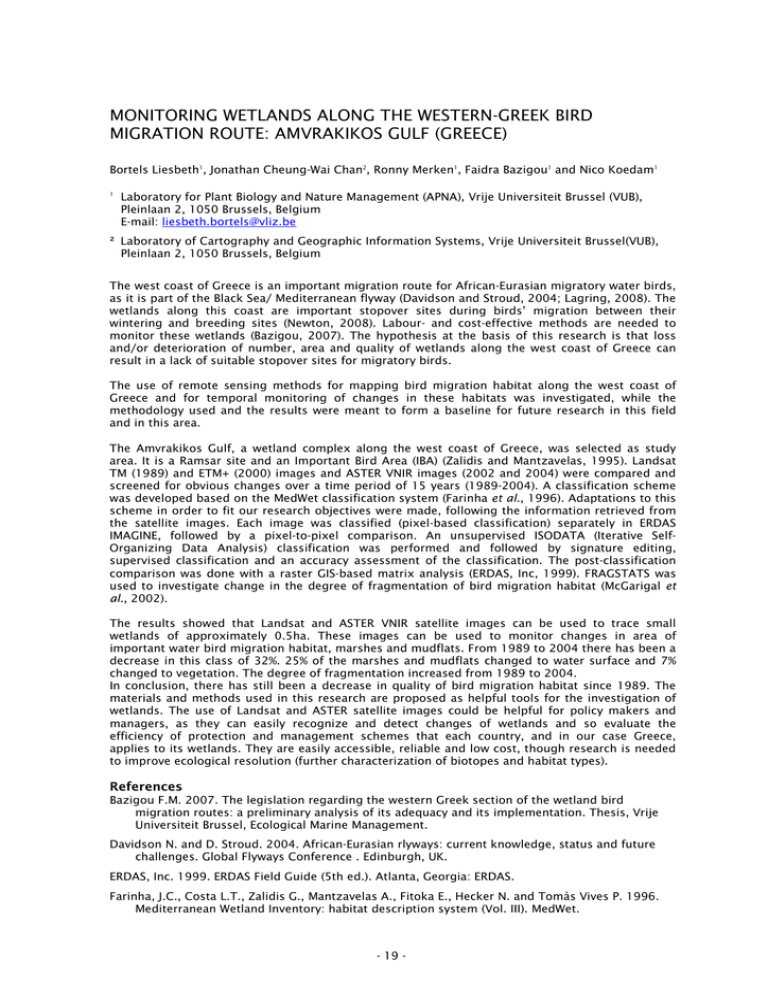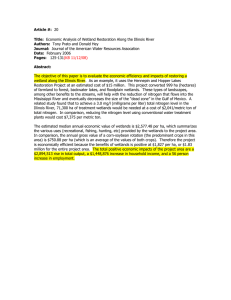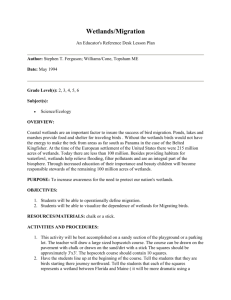MONITORING WETLANDS ALONG THE WESTERN-GREEK BIRD MIGRATION ROUTE: AMVRAKIKOS GULF (GREECE)
advertisement

MONITORING WETLANDS ALONG THE WESTERN-GREEK BIRD MIGRATION ROUTE: AMVRAKIKOS GULF (GREECE) Bortels Liesbeth1, Jonathan Cheung-Wai Chan2, Ronny Merken1, Faidra Bazigou1 and Nico Koedam1 1 Laboratory for Plant Biology and Nature Management (APNA), Vrije Universiteit Brussel (VUB), Pleinlaan 2, 1050 Brussels, Belgium E-mail: liesbeth.bortels@vliz.be ² Laboratory of Cartography and Geographic Information Systems, Vrije Universiteit Brussel(VUB), Pleinlaan 2, 1050 Brussels, Belgium The west coast of Greece is an important migration route for African-Eurasian migratory water birds, as it is part of the Black Sea/ Mediterranean flyway (Davidson and Stroud, 2004; Lagring, 2008). The wetlands along this coast are important stopover sites during birds’ migration between their wintering and breeding sites (Newton, 2008). Labour- and cost-effective methods are needed to monitor these wetlands (Bazigou, 2007). The hypothesis at the basis of this research is that loss and/or deterioration of number, area and quality of wetlands along the west coast of Greece can result in a lack of suitable stopover sites for migratory birds. The use of remote sensing methods for mapping bird migration habitat along the west coast of Greece and for temporal monitoring of changes in these habitats was investigated, while the methodology used and the results were meant to form a baseline for future research in this field and in this area. The Amvrakikos Gulf, a wetland complex along the west coast of Greece, was selected as study area. It is a Ramsar site and an Important Bird Area (IBA) (Zalidis and Mantzavelas, 1995). Landsat TM (1989) and ETM+ (2000) images and ASTER VNIR images (2002 and 2004) were compared and screened for obvious changes over a time period of 15 years (1989-2004). A classification scheme was developed based on the MedWet classification system (Farinha et al., 1996). Adaptations to this scheme in order to fit our research objectives were made, following the information retrieved from the satellite images. Each image was classified (pixel-based classification) separately in ERDAS IMAGINE, followed by a pixel-to-pixel comparison. An unsupervised ISODATA (Iterative SelfOrganizing Data Analysis) classification was performed and followed by signature editing, supervised classification and an accuracy assessment of the classification. The post-classification comparison was done with a raster GIS-based matrix analysis (ERDAS, Inc, 1999). FRAGSTATS was used to investigate change in the degree of fragmentation of bird migration habitat (McGarigal et al., 2002). The results showed that Landsat and ASTER VNIR satellite images can be used to trace small wetlands of approximately 0.5ha. These images can be used to monitor changes in area of important water bird migration habitat, marshes and mudflats. From 1989 to 2004 there has been a decrease in this class of 32%. 25% of the marshes and mudflats changed to water surface and 7% changed to vegetation. The degree of fragmentation increased from 1989 to 2004. In conclusion, there has still been a decrease in quality of bird migration habitat since 1989. The materials and methods used in this research are proposed as helpful tools for the investigation of wetlands. The use of Landsat and ASTER satellite images could be helpful for policy makers and managers, as they can easily recognize and detect changes of wetlands and so evaluate the efficiency of protection and management schemes that each country, and in our case Greece, applies to its wetlands. They are easily accessible, reliable and low cost, though research is needed to improve ecological resolution (further characterization of biotopes and habitat types). References Bazigou F.M. 2007. The legislation regarding the western Greek section of the wetland bird migration routes: a preliminary analysis of its adequacy and its implementation. Thesis, Vrije Universiteit Brussel, Ecological Marine Management. Davidson N. and D. Stroud. 2004. African-Eurasian rlyways: current knowledge, status and future challenges. Global Flyways Conference . Edinburgh, UK. ERDAS, Inc. 1999. ERDAS Field Guide (5th ed.). Atlanta, Georgia: ERDAS. Farinha, J.C., Costa L.T., Zalidis G., Mantzavelas A., Fitoka E., Hecker N. and Tomàs Vives P. 1996. Mediterranean Wetland Inventory: habitat description system (Vol. III). MedWet. - 19 - Lagring R. 2008. Monitoring wetlands along the 'Western Greek Bird Migration Route': Spatiotemporal change detection using remote sensing and GIS in Logarou Lagoon, Western Greece: a pilot study. Thesis, Vrije Universiteit Brussel, Plant Biology and Nature Management. McGarigal K., B.J. Marks, C. Holmes and E. Ene. 2002. FRAGSTATS: Spatial Pattern Analysis Program for Quantifying Landscape Structure (Version 3.3 build 5). University of Massachusetts, Amherst. Newton I. 2008. The migration ecology of birds. Elsevier. Zalidis G.C. and A.L. Mantzavelas. 1995. Inventory of Greek wetlands as natural resources (first approximation). Greek Biotope/ Wetland Centre (EKBY). - 20 -





